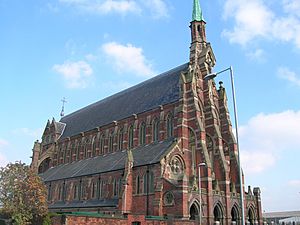List of monastic houses in Greater Manchester facts for kids
Have you ever wondered about the old buildings in Greater Manchester? Many years ago, long before cities looked like they do today, there were special places called monastic houses. These were homes for groups of religious people, like monks or friars, who dedicated their lives to prayer and work. They often lived together in communities, following strict rules.
These houses played an important role in medieval society. They were not just places of worship; they were also centers for learning, farming, and helping the poor. Some of them were very large and powerful, while others were small and simple.
In Greater Manchester, several of these monastic houses existed. Let's explore some of them and learn about their history.
Contents
Exploring Monastic Houses in Greater Manchester
Here are some of the interesting monastic houses that were once found in the Greater Manchester area.
Gorton Monastery
The Church and Friary of St Francis in Gorton Monastery is a special place. It was home to the Franciscan Friars. Unlike many older monastic houses that were closed down centuries ago, Gorton Monastery is still around today. It's a beautiful building that shows how these religious communities lived and worshipped.
Kersal Priory
Kersal Priory was a monastic house dedicated to St Leonard. It started as a small hermitage, which is a place where a single religious person lives alone. Later, it became home to Cluniac monks.
This priory had an interesting history. It was founded sometime between 1145 and 1153. For a long time, it was an "alien house," meaning it was controlled by a larger monastery in Lenton, Nottinghamshire. This changed in 1392 when Kersal Priory became independent. However, like many other monasteries in England, it was eventually closed down in 1538.
Marland Grange
Marland Grange was a place connected to Cistercian monks. A "grange" was like a farm or estate that belonged to a monastery. Marland Grange was first part of Stanlow Abbey in Cheshire. Later, it became linked to Whalley Abbey. This grange was established before the year 1212. Its exact location today is not fully known, but it was an important part of the Cistercian monks' farming activities in the region.
Warburton Priory
Warburton Priory was a small monastic community, sometimes called a "cell." It was home to Premonstratensian Canons. This priory was a daughter house, meaning it was dependent on a larger monastery called Cockersand Abbey in Lancashire.
Warburton Priory was founded around the year 1200. The church of St Mary and St Werburgh was given to Cockersand Abbey by a person named Adam of Dutton. Sadly, this small priory was abandoned before 1271, meaning the canons left and it stopped being an active monastic house. It was also known as Warburton Cell.
See also


